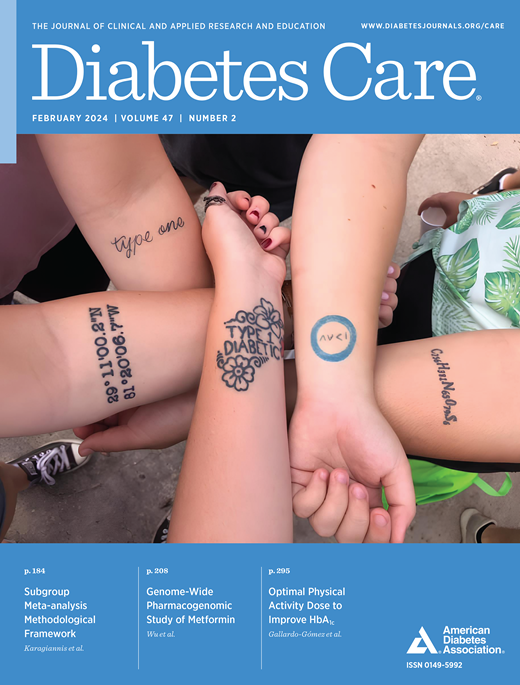经皮血液采样检测 C 肽是 1 型糖尿病儿童和成人静脉采样的一种微创、可靠的替代方法
IF 14.8
1区 医学
Q1 ENDOCRINOLOGY & METABOLISM
引用次数: 0
摘要
目的 C 肽和胰岛自身抗体是关键的 1 型糖尿病生物标志物,通常需要静脉采样,这限制了它们的实用性。我们评估了作为一种实用替代方法的透皮毛细血管血液(TCB)采集。研究设计与方法 91 名患者(71 名 1 型糖尿病患者,20 名对照组患者;1 型糖尿病患者:年龄中位数为 14.8 岁 [四分位数间距 (IQR) 9.1-17.1],糖尿病病程为 4.0 年 [1.5-7.7];对照组患者:年龄中位数为 42.2 岁 [四分位数间距 (IQR) 38.0],糖尿病病程为 4.0 年 [1.5-7.7]:42.2岁[38.0-52.1])的1型糖尿病患者同时接受静脉和TCB采样,以测量血浆C肽。1 型糖尿病患者还提供了静脉血清和血浆以及 TCB 血浆,用于测量谷氨酸脱羧酶、胰岛抗原-2 和锌转运体 8 的自身抗体。使用 Bland-Altman 方法比较了 TCB 血浆检测显著内源性胰岛素分泌(静脉 C 肽≥200 pmol/L)的能力以及水平的一致性。使用既定阈值比较静脉血清与静脉血浆和 TCB 血浆检测自身抗体的情况。通过与年龄相适应的问卷评估接受度。结果 经皮采样平均耗时 2.35 分钟(标度 1.49)。样本量中位数为 50 µL(IQR 40-50),91 例中有 3 例(3.3%)失败,88 例中有 13 例(14.7%)<35 µL。TCB C肽与静脉血浆显示出良好的一致性(平均静脉ln[C肽] - TCB ln[C肽] = 0.008,95% CI [-0.23, 0.29],检测静脉C肽≥200 pmol/L的灵敏度为100% [36项中的36项]/特异性为100% [50项中的50项])。在多种自身抗体阳性的 TCB 血浆中,静脉血清与 32 例中的 22 例一致(灵敏度为 69%),特异性为 36 例中的 35 例(97%)。TCB 比静脉采样更受青睐(1 型糖尿病:63% 对 7%;30% 未作决定)。结论 经皮毛细血管检测C肽是一种灵敏、特异、可接受的静脉采样替代方法;TCB采样检测胰岛自身抗体还需进一步评估。本文章由计算机程序翻译,如有差异,请以英文原文为准。
Transdermal Blood Sampling for C-Peptide Is a Minimally Invasive, Reliable Alternative to Venous Sampling in Children and Adults With Type 1 Diabetes
OBJECTIVE C-peptide and islet autoantibodies are key type 1 diabetes biomarkers, typically requiring venous sampling, which limits their utility. We assessed transdermal capillary blood (TCB) collection as a practical alternative. RESEARCH DESIGN AND METHODS Ninety-one individuals (71 with type 1 diabetes, 20 controls; individuals with type 1 diabetes: aged median 14.8 years [interquartile range (IQR) 9.1–17.1], diabetes duration 4.0 years [1.5–7.7]; controls: 42.2 years [38.0–52.1]) underwent contemporaneous venous and TCB sampling for measurement of plasma C-peptide. Participants with type 1 diabetes also provided venous serum and plasma, and TCB plasma for measurement of autoantibodies to glutamate decarboxylase, islet antigen-2, and zinc transporter 8. The ability of TCB plasma to detect significant endogenous insulin secretion (venous C-peptide ≥200 pmol/L) was compared along with agreement in levels, using Bland-Altman. Venous serum was compared with venous and TCB plasma for detection of autoantibodies, using established thresholds. Acceptability was assessed by age-appropriate questionnaire. RESULTS Transdermal sampling took a mean of 2.35 min (SD 1.49). Median sample volume was 50 µL (IQR 40–50) with 3 of 91 (3.3%) failures, and 13 of 88 (14.7%) <35 µL. TCB C-peptide showed good agreement with venous plasma (mean venous ln[C-peptide] – TCB ln[C-peptide] = 0.008, 95% CI [−0.23, 0.29], with 100% [36 of 36] sensitivity/100% [50 of 50] specificity to detect venous C-peptide ≥200 pmol/L). Where venous serum in multiple autoantibody positive TCB plasma agreed in 22 of 32 (sensitivity 69%), comparative specificity was 35 of 36 (97%). TCB was preferred to venous sampling (type 1 diabetes: 63% vs. 7%; 30% undecided). CONCLUSIONS Transdermal capillary testing for C-peptide is a sensitive, specific, and acceptable alternative to venous sampling; TCB sampling for islet autoantibodies needs further assessment.
求助全文
通过发布文献求助,成功后即可免费获取论文全文。
去求助
来源期刊

Diabetes Care
医学-内分泌学与代谢
CiteScore
27.80
自引率
4.90%
发文量
449
审稿时长
1 months
期刊介绍:
The journal's overarching mission can be captured by the simple word "Care," reflecting its commitment to enhancing patient well-being. Diabetes Care aims to support better patient care by addressing the comprehensive needs of healthcare professionals dedicated to managing diabetes.
Diabetes Care serves as a valuable resource for healthcare practitioners, aiming to advance knowledge, foster research, and improve diabetes management. The journal publishes original research across various categories, including Clinical Care, Education, Nutrition, Psychosocial Research, Epidemiology, Health Services Research, Emerging Treatments and Technologies, Pathophysiology, Complications, and Cardiovascular and Metabolic Risk. Additionally, Diabetes Care features ADA statements, consensus reports, review articles, letters to the editor, and health/medical news, appealing to a diverse audience of physicians, researchers, psychologists, educators, and other healthcare professionals.
 求助内容:
求助内容: 应助结果提醒方式:
应助结果提醒方式:


